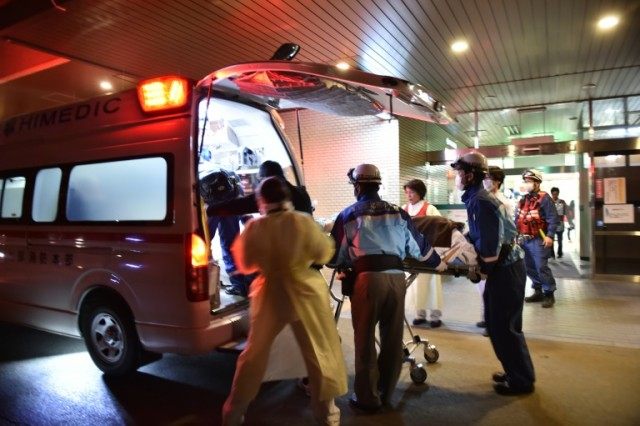Mashiki (Japan) (AFP) – Rescuers desperately searched through the night for victims trapped in rubble after a powerful quake hit southern Japan, killing at least two and causing major damage, just over a day after another strong tremor in the same area.
The quake on the southwestern island of Kyushu sparked a fresh wave of destruction and was followed by a wave of aftershocks in the region where nerves are already frayed following Thursday’s earthquake that killed nine people.
The powerful shaking triggered a huge landslide that swept away homes and cut off a highway in one area, and unlike the earlier quake which mostly affected old houses, larger buildings were damaged and some toppled across Kumamoto prefecture, the epicentre of the quakes.
Public broadcaster NHK said that at least 470 people were injured in the latest tremor, while a government spokesperson said scores were trapped or buried alive.
Eleven people were stuck in a damaged apartment building in Minami-Aso near the landslide, a Kumamoto prefecture official said.
“We don’t know their condition,” he said, declining to be named.
Meanwhile, a large fire that broke out at an apartment complex in Yatsushiro city killed one person, city official Kiichiro Terada confirmed.
“We are also checking if any more people failed to escape,” he said, adding that the fire was under control.
NHK reported four dead in total, but Kumamoto officials gave a total a tally of two.
In nearby Kumamoto city, authorities were evacuating patients from a hospital over fears it could collapse and images showed the building slanted.
Hisako Ogata, 61, evacuated to a nearby park with her daughter, where some 50 other people sat on blue plastic sheets.
“We left my house as we could not stay due to continuous jolts,” Ogata told AFP.
“It was so scary,” she added. “Thank God we are still alive.”
An AFP journalist in the city at the time said he was jolted awake by powerful shaking, which sent the television set in his hotel room crashing to the floor. Staff urged guests to evacuate.
– ‘Really strong’ –
A ceiling at Kumamoto airport collapsed from the shaking, forcing the airport closed, Jiji Press reported, with no immediate plans to resume flights, and communications in the area were spotty.
The quake, measured at magnitude 7.0 by the US Geological Survey, struck at 1:25 am (1625 GMT Friday) at a depth of 10 kilometres (6.2 miles).
The Japan Meteorological Agency, which put the magnitude at a revised 7.3, initially issued a tsunami warning for the western coast of Kyushu but later lifted it.
Thursday night’s quake was measured at magnitude 6.2 by USGS, and 6.5 by the Japanese agency.
Some 20,000 soldiers will be deployed to the area over the weekend to help rescue efforts, Defence Minister Gen Nakatani told reporters.
Shotaro Sakamoto, a Kumamoto prefectural official, said Saturday’s quake felt comparable to Thursday’s.
“It was really strong… many people on the street appeared panicked,” he told AFP.
Meteorological agency official Gen Aoki said Saturday’s earthquake was the strongest to hit Japan in recent days, and said Thursday’s was merely a “precursor”.
Japanese Prime Minister Shinzo Abe was due to visit Kyushu later Saturday to inspect damage and rescue efforts, but Jiji Press reported his trip was cancelled.
“We are trying our best to assess the damage situation as it could spread,” he told reporters early Saturday.
Japan, one of the most seismically active countries in the world, suffered a massive undersea quake on March 11, 2011 that sent a tsunami barrelling into the country’s northeast coast.
Some 18,500 people were left dead or missing, and several nuclear reactors went into meltdown at the Fukushima plant in the worst atomic accident in a generation.
A nuclear plant on Kyushu was unaffected by Saturday’s quake, Chief Cabinet Secretary Yoshihide Suga, the top government spokesman, told reporters.

COMMENTS
Please let us know if you're having issues with commenting.